
Cripes on Infinite Earths Part 1: Superman’s Metropolis
September 15th, 2010 by guest article | Tags: elseworlds, lex luthor, lois lane, superman(Gavok note: On the heels of Marvel announcing What If #200, it’s fitting to take on the topic of alternate reality stories. Truth be told, the idea of doing an Elseworlds list much like how I did one with What If has been a looming menace hanging over my head and for years I’ve been afraid of forcing the other shoe to drop. Thankfully, Fletcher “Syrg” Arnett was inspired enough to fight the dragon in my stead and has offered to do a series of guest articles on the subject. You might remember Syrg from his fantastic take on the comic disaster Marville last year. If you don’t, go read it anyway. He’s good people. I plan to throw my hat into his series here at least twice before he’s finished, since there are a couple Elseworlds that I feel the need to talk about. This includes one that I’ve considered to be the worst comic I’ve ever read that I’ve been putting off writing on for years. But enough about me. It’s Syrg’s show. Enjoy.)
Marvel has their What If…?s, and DC has their own brand of “But what happens if we take X and change Y?” tales, called, depending on when you ask, Elseworlds/”Tales of the Multiverse”. (Juuuuust kidding. I don’t think anyone aside from Dan DiDio has ever used that last one seriously.)
The thing is, though, Marvel’s usually (I added the qualifier for a reason, Gavok, I know about that Timequake crap) come from a formula of “take big event/origin of character, change outcome slightly, go from there”. DC runs a little looser with the format, like that one where Bruce Wayne is an amnesiac immortal and Alfred is actually Merlin. Or the time the Justice League had to mount an assault on the Planetary Organization to break their shadowy hold over the planet. Maybe you know the one where Lex Luthor, singer-turned-record executive, sold his media empire to Darkseid?
Elseworlds are almost always entertaining, intentionally or not, because before 2010 and a run of titles like Rise of Arsenal and that other trainwreck I forget the name of*, you never thought you’d be buying a DC book where Superman got turned into a gender-swapped nazi centaur. (We’ll get to that one. Later.) Point is, the fact that so many of these are out of print and forgotten is a damn shame, and so just like Gavok running through all the What If…?s in the world, I’ll hit every damn Elseworld I can get my hands on, and probably a few other eccentric DC projects that didn’t earn that banner, usually because they were written too early or too late.
There’s going to be a lot less order to this than Gavok’s project. For one thing, I don’t think there’s any way to come up with a coherent set of criteria/checklist to hit for all of these, and I’m unsure as to what the “Peter Parker Dies” of Elseworlds is. Probably “Martian Manhunter Out of Fucking Nowhere”, that dude shows up a lot in the otherwise-grounded stories (and it’s usually to inspire Superman to go use his goddamn powers, that guy takes pacifism way too seriously in these).
Also: no order, no rankings. Some of these are books I haven’t even looked through since I picked them up, and this project is good motivation to finish looking at the beaten-down copies of a couple. There’s no way I’ll be able to come up with a full scale to judge them on and pick a favorite. (Even if I did, people would bitch at me forever because technically, Kingdom Come is an Elseworld, and lord knows the kvetching if I put that below something like Speeding Bullets.) In fact, let’s just say it: I’m skipping a lot of the big ones. Kingdom Come/The Kingdom, Red Son, Destiny (since Gavok covered it a while back), Dark Knight Returns/Strikes Back. (I want to skip True Brit because it’s rather awful, but I suppose I’ll play canary in the coalmine for people who might go “John Cleese? Sold!”) I leave myself wiggle room on this as I go, but rest assured I’ll give you more than those and then some in extras by the time we’re done.
This is getting to be a bit text heavy. Let’s dive into the first book, Elseworlds: Superman’s Metropolis.
Superman’s Metropolis is an interesting book for a variety of reasons. It’s why I started off with it. But first, let’s look at the stats:
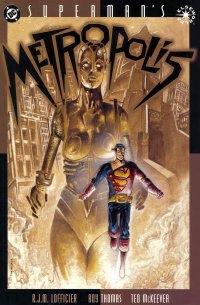
Superman’s Metropolis
Focuses on: Superman (for now)
Self-contained/Multiple books: Multiple (trilogy)
Published in: 1996
Central premise: Superman and cast as placed into Fritz Lang’s Metropolis
Martian Manhunter Out of Fucking Nowhere? No
Recap time: Fritz Lang’s Metropolis was a silent 1927 sci-fi film about a capitalist dystopia: the owners were men who lived in a city of lights, their children growing up in a garden of lights and greenery without want, as beneath their city, the workers became little more than fodder for the machinery that ran the overcity, identically exhausted and broken, shifts running eternally around the clock to keep the world they knew running, their children doomed to the same labors as they grew. I’ll go into more of that as we get into the book when I start comparing it to the film.
The other interesting thing, though, is the history and treatment that Metropolis has had over the decades. Various restorations and arguments over the film’s speed and score have ensued over the decades, but this past year the most complete reconstruction (to date? possibly that we’re going to get) was completed off of prints found in Argentina and New Zealand. I saw this film for the first time this year, with said reconstruction. I’ve been told it made a lot of sense of things left dangling in prior American edits and pre-restored versions, as a less thorough but better-than-our-original version has been around for around a decade now prior to this.
I mention this because the publishing date on this Elseworld puts it before those two major leaps forward, and so explains some of the things that I know about the movie in 2010 not matching up with a mid-1990s writer’s take on the film. In short: these preceding paragraphs were a preemptive “I know, get off my ass” in case someone starts calling me on the fact that a scene I mention isn’t mirrored in the book. I’m using a list of what scenes were added to the late-90s restoration to try and figure out where I need to add that in, but I’m only human.
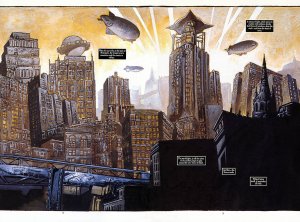
The art is rather good, by the way. The editing, not so much.
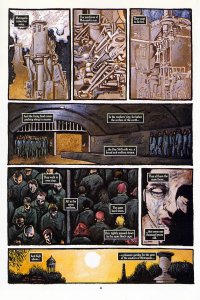
And the first so many pages are almost shot-for-shot recreations of the film. The lone thing you’re missing here is the completely synchronized downtrodden pace of the workers departing and arriving. (Also the aforementioned black caps? Worn once in the entire story that I spotted in my reread. Sort of odd to leave that line in there from the film’s cards and then not draw them.)
We’re introduced to Clarc Kent, son of Jon-Kent, Metropolis’ architect and ruler, playfully chasing a woman named Lana through the gardens of the upper city. Lana ceases to have any bearing on the story shortly as a woman from the undercity named Lois comes up, bringing the children of the workers with her to see the gardens. They’re told to leave, not being privileged to be there, and do so, Lois catching the eye of an intrigued Clarc in the meanwhile. He follows her down into the depths, but not knowing the way (having never left the overcity), he finds himself among the workers and the machines.
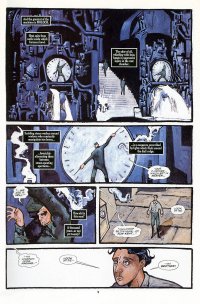 <
< 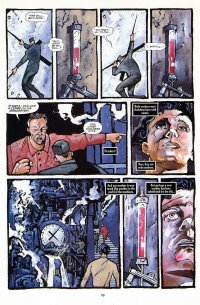
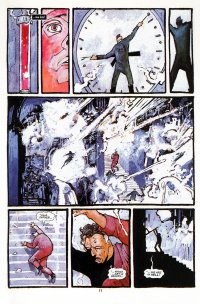
I really, really like the way this style alternates between the barely-humanized workers and the overcity dwellers throughout. A note of film to comic trivia: the name of the machine in question was actually the M-Machine. The name Clarc’s using here was actually a hell of a shock given that he sees this horrible machine in action, working men to death to keep it pumping, and it turns into a vision before him, then this caption appears from nowhere:

It’s a stunning effect against the standard text of the other cards in the film, and it’s kind of a letdown such a scene just gets covered as “poof”. But anyhow. We first meet Joh Fredersen (now Jon Kent) here, dictating a memo to his secretary, known only as Olson. Like the film, the fact that his son was a) allowed down into the undercity, and b) HE’S the one bringing the news of the accident to his attention causes him to turn on Olson, and fire him – effectively a death sentence, as now the soft man is going to be forced into labor in the undercity. While Clarc angrily storms out, Kent’s chief of security brings him two papers found in the pockets of the dead workers- “two more” among many that continue to mystify him. Unable to decipher them on his own, he heads off to meet his old partner, Lutor.
(The film splits from the restoration I saw here- the older version excised several subplots, none of which appear here, some altered entirely to try and cover up their obvious gaps. Here, for instance, when alone with the security informant, the movie’s Joh Fredersen begins sending a spy known only as ‘the Thin Man’ to watch over his son, should he risk himself again. This ties into later cut bits I’ll get to.)
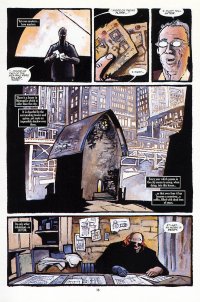
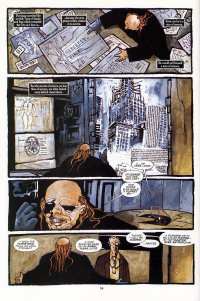
Here’s where we begin diverging from the film wildly, though. Lutor’s equivalent, Rotwang (snicker now, get it over with), was a former partner to Fredersen and the two parted ways when a woman named Hel came between them. She chose Fredersen over Rotwang, and died giving birth to his son. The two never really reconciled from such, and only desperation at the mysterious plans causes the master of the city to turn to his old comrade’s similarly-gifted mind. Here, Kent and Lutor both helped build the city as co-architects, and Marta chose Kent, splitting the pair. Buuuuut rather than becoming a recluse who wanted to ruin the dreams of the optimist Kent, he instead murdered Marta himself and reduced Kent to his own hypnotized puppet, silently turning the city of dreams into “…the canvas on which [he] paints a masterpiece of pain and misery”. Similarly, Joh’s secretary nearly committed suicide after being dismissed from his service, but Freder (Clarc’s equivalent) stops him, and the two begin trying to aid the workers and improve their lives. After doing so, Freder heads into the machines again, takes over for a nameless man who falls down at the M-Machine, and begins to work a shift, trading outfits with him. In the book, Olson is the man who Clarc replaces, and he shuffles off into the night, then fulfilling his original role as companion to Clarc-in-disguise throughout the tale. (The restoration added a new plot to the young man who traded lives with Freder – finding large amounts of money in the young nobleman’s pockets, he heads to the red light district and splurges all evening. The Thin Man finally catches on that he’s been tracking the wrong man, and threatens the young man to disappear back to the undercity, at which point the doppleganger’s story ends.)

Notice also how Clarc’s features begin to disappear while he works the shift – a subtle touch to the dehumanizayou know what I think you all get it now, I like the work they put into the art and symbolism throughout this book. I’ll stop pointing it out (on the workers, anyway…)
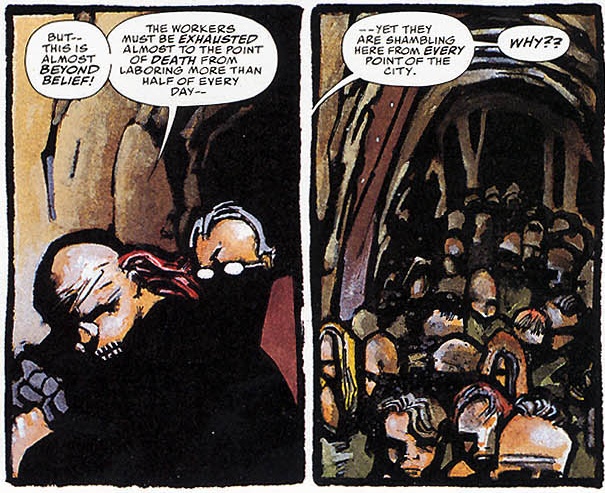
Lutor, meanwhile, ends up shown more often than not in shadow, or with jagged/skull’s teeth, and Kent, helpless thrall, is as blank-faced as any worker (sometimes shown with bluish lips for god knows why), save for his glowing glasses. Cocky as ever, Lutor deduces the papers are plans of the city catacombs, and they take a tunnel under his crooked house to watch the workers pour into them from above.
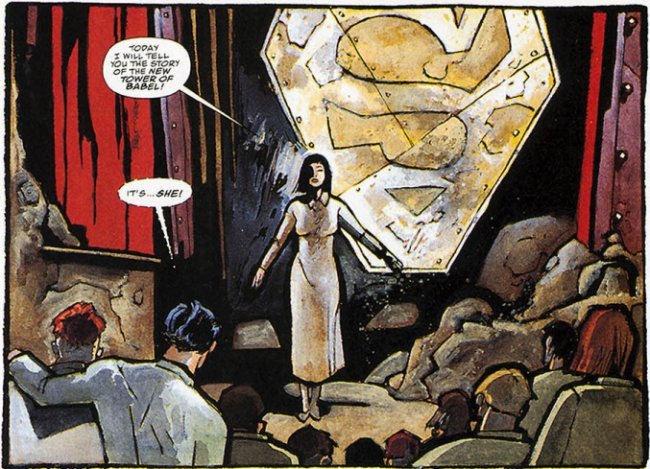
With Lois’ full introduction, we now have our full cast, and the stage is set. She preaches to the workers of a “super-man”, a mediator who will bring unity back between the upper and lower class, while a few (including a man referred only to as “Turpin”) gripe that they’ve waited too long for such. They agree that while she preaches to the masses, they’ll stay quiet, but should more grow dissatisfied, violence towards the city is inevitable. Clarc stays behind after the meeting to speak to her, and says he will be her Superman. She hands him a steel emblem in the shape of that malformed S behind her above, and Olson recognizes it as something from his father’s “secret diaries”. (Those, uh… were not in the film. Period. Emblem or diaries.)
Here, like the M-Machine, another impressive scene comes through a little less so – Lutor/Rotwang chases the young woman through the tunnels as she heads her own route home, only his lantern illuminating things as he slowly trods after her, and she’s tricked into heading up the path to his home, captured by the mad scientist. In the book’s defense, it’s a hell of a challenge to make a full-color book capture this scene so well compared to the black and white tunnels with only that lantern glow to show the chase… and the few words spoken between the two here say plenty.
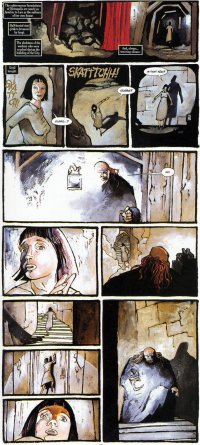
In a scene which mirrors the film, but is hilarious in the wake of Paul Cornell’s current Action Comics run, Lutor copies Lois’ image onto a robot he has been making, to set her loose in the tunnels and cause an uprising for his own ends. Meanwhile, Clark and Olson sneak into Jon Kent’s study and discover… Clarc’s origin!
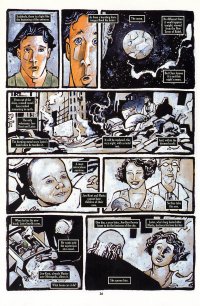
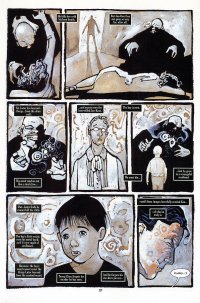
Hands up if you know where this is all going now that we’ve seen how his landing turned out. Anyone? But we cut back from that to Lois being unleashed on the workers, sermons now turning from tolerance to terrorism, and she leads the workers to the M-Machine, whose destruction, a dissenting Perry White points out, would flood the undercity and slaughter scores of innocents (including the workers’ own children, the only people who should be there while everyone else is on-shift or rioting).
Okay, one more on the art for a second. So in the film, the same actress (Brigitte Helm) played both Maria and the machine-Maria. As a first test, and additional chaos in the city, the machine was allowed to dance in one of the upper city’s clubs for a night, where she was seen to be so erotic that men murdered each other in vain hopes of being the one who might get her attention.
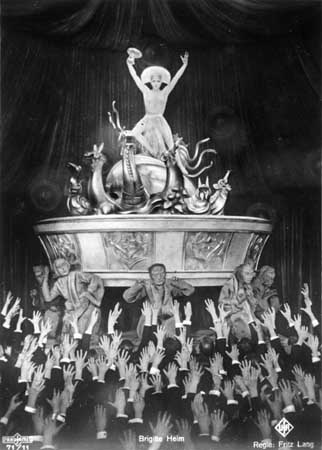
It was a bit of a moral fabric/”sex is bad” kind of thing, to be sure, but the way she portrayed what was effectively the same person in such radically different ways (her facial expressions and body language changed entirely, so you were never confused as to which she played in a scene, especially amongst the ending’s chaos) was stunningly effective. Here, the artist (Ted McKeever, just realized I never named him amongst the praise) actually started giving similar touches to her face and body language while speaking. Whereas normal Lois was always well-postured, shoulders-up and looking out happily at the crowd, or smiling…
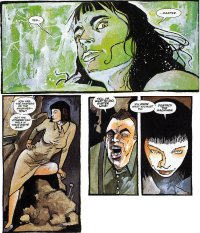
…the machine-Lois is shown with a calculating, villainous expression, and a posture meant to entice, not enlighten, those onlookers who gaze at her form. It’s another good way to pay homage to the film, and I felt it needed to be pointed out in here since I’m trying to keep only the most important parts in panels rather than post the entire book and go “Here, read”.
From here on out we hit on a problem that comes into play with a lot of Elseworlds: the ending always has to be a showdown of some sort, or a climactic scene. You might have noticed in the info box at the top of this, I wrote “Martian Manhunter Out of Fucking Nowhere”? Well, half the time, if Superman’s the focus of an Elseworld, that’s what spurs him into action – he’ll be in a hospital or biding his time somewhere and a detective named John Johns/Jones is OH SHIT A GREEN MAN, maybe we can all get along or something, but go kick Brainiac’s ass, Clark! It’s not so bad in this one, but we do get a bit of a rush as in the remaining pages (there are about 20), we have to go through:
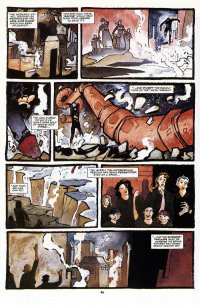
– Clarc saving the women and children of the undercity (fun note: in the film, the women, too, worked in the machinery, and the children were all left alone in the city. The true Maria and Freder were the only ones to rescue them from the flooding undercity as it crumbled. Also, it was just water. The machines were steam powered, not… hot boiling metal… powered? I don’t even know how the fuck that works.)
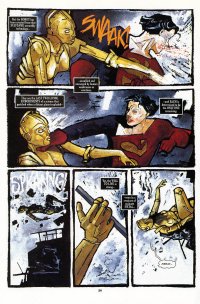
– Beating down mecha-Lois, who apparently wears a skin of liquid metal and can shapeshift, as she transforms to and from robot form in the fight to mess with Clarc. I suspect the fact that the machines involve vats of boiling metal is just so we can have a massive Terminator callback here, because that’s exactly how the doppleganger is destroyed.
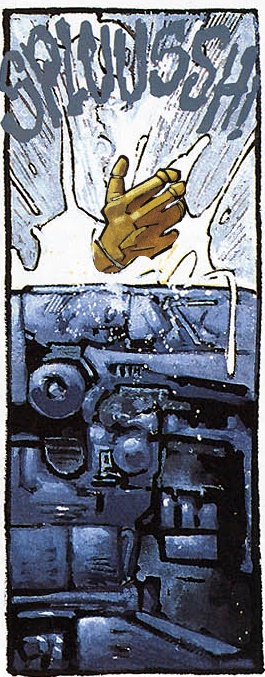
Poor thing. It had to die for the future’s sake, inhuman eroticism or no.
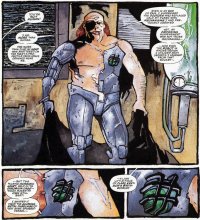
– Naked robot Lutor. Honestly I don’t need to sum up more than what the man himself says when he disrobes before human-Lois, still his prisoner at the time. He then starts running around the city, perfectly pantsless for the rest of the book. I’m still trying to figure out how the hell he lost his junk and, well… the rest of himself. I know the hand got burned when the spacecraft landed, how did the rest of him… and he said it happened that night… uh…
Did Lutor fuck a still-smoldering spacecraft? That’s seriously going to bother me for the rest of this writeup. Hey quick topic change: we know he’s running around pantsless because he has nothing on when…
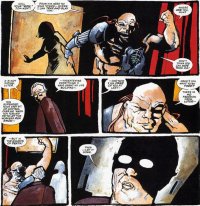
– Lutor murders Jon Kent. I have to give him props, though, that’s a damn good comeback for when your puppet rejects you on the eve of your unravelling plans… and since it’s Lex Luthor, you know he damn well didn’t prepare it ahead of time, he thought he was infallible. Okay, so all that happened in 10 pages, and we still have…
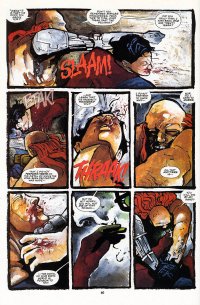
– A big brawl with mecha-Lutor. To close out the final scene of the film, where mistaken identity leads the crowd to burn alive the mechanical maiden (thinking that she’s caused them all to kill their children, not knowing better in the night’s chaos), while Rotwang thinks the woman he’s captured is his robot and not the real Maria, Freder and Rotwang fight atop the cathedral he’s taken his hostage to while trying to escape. Here, Lutor screams for Clarc to fight him or he’ll throw Lois from the rooftop. A kryptonite heart weakens the superman, but… uh… Okay, I know I’ve praised the art a lot, but this is the sole part that I just don’t get in the book.
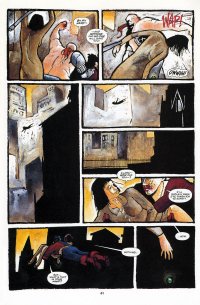
I’m unsure entirely what Lois DOES here to pry the kryptonite out of Lutor’s heart. I know she has the pole raised like she’s going to bring it down on his head, and then suddenly it’s behind her as the rock falls from his chest (you can see it in the corner of the panel)… but it just looks like he turned around and backhanded her. I’m not quite sure what the hell the pipe did to remove the rock. (Or why Clarc, who got weak instantly in the presence of the thing, didn’t fall to the ground if she was carrying it mid-flight, even closer to him than Lutor was at first.)
Anyway we have… oh man, three pages to wrap this up? Uh, shit… well we just spent one on a kiss in front of the setting sun, and another on Lutor falling off of a rooftop and exploding (really), so that leaves… uh… and then the last page is just a quick speech from them in front of the crowd going “Look! Peace in our time!” and Clarc repeating a line that was drilled into you in the film: “The mediator between head (the upper city visionaries) and hands (laborers below) must be the heart!” Since we don’t have Jon to be the “brain” here, Lois (who is of the lower class) and Olson (who was JUST banished, seriously) represent the upper half. Unlike the film’s ending of foreman and inventor being forced into a handshake by Freder, the heart-mediator, the two sides stand at odds on other ends of a stage as Clarc speaks to the crowd. It’s not really the best show of good faith from either side, is all I’m saying. “Yeah, I want to stay AT LEAST one Superman-length away from THOSE assholes at all times.”
As I mentioned above, Superman’s Metropolis is the first part of a trilogy of Elseworlds, based on German cinema. The next, Batman: Nosferatu… is barely based on Nosferatu. It follows the story of The Cabinet of Dr. Caligari instead, and having not seen such, it’s going to drop down the list a bit until I can track down its inspiration. Maybe it’ll serve as a center to this series of articles, and I’ll wrap up with Wonder Woman: The Blue Amazon at the end. In the meantime, though, we’re going to cover a different Batman story instead, because there are way too many Batman Elseworlds and I want to get through as many as I can early on before they become a grind. So on that note, next time:
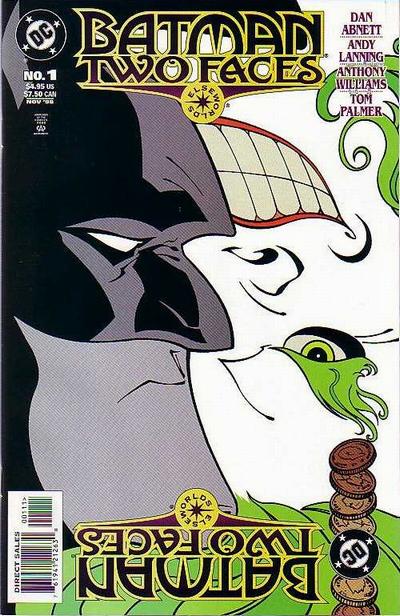
* Hah! Bet you scrolled down here either to see if I picked on a story you liked, or to make some snarky comment about “I know what it was, it’s (whatever you hated)!” Well, too bad.

This is going to be a lengthy read. Kudos for you starting it. I don’t think I’d have the ability to slog through DC’s entire Elseworlds collection.
I’d be interested to see more since I didn’t realize that Superman’s Metropolis compared itself too similarly to an old source material. Makes me wonder if other Elseworlds were similarly inspired.
That said, True Brit is fun for me. 🙂
Great write-up. I love the idea of Elseworlds, but I’ve only read a few of them. Keep these coming!
Actually, in the last panel on page 60 you can see Clarc grasping at Lutor’s chest-hole. It seems to me that he must have torn open the grating which caused the rock to fall from its nest, which was then caught by Lois for some reason. Perhaps her having it and then dropping it was meant to symbolize something or other, but in any case it was Clarc who got it out.
@MarkPoa: The sample I’ve read before are, for the most part, nowhere nearly as mimicked from another source. (So of course I say this before going into one that’s got a Jekyll and Hyde thing going on.)
@Matt: You bet. They may be a few days between each, unlike the Marville articles, but I intend to see this pile through.
@Joe England: Heeey, that makes more sense. I can’t think of any real symbolism to it, though, in or out of the film. I guess it was just to call more attention to it for people like me who might miss that.
Y’know, where this project fails, to me, is that it attempts to merge Metropolis and the Superman mythos in a fairly superficial way. All they really do is mix elements of plot and origin story while leaving the morals unchanged. What was needed, I think, was a merging of a different sort. Instead of preserving details and meshing them on top of one another, they should have changed the stage to create something new with elements of both.
Like… the theme of the original Metropolis was separation of the upper and lower classes. Well what if the “upper class” in this world were the superheroes? Or the Kryptonians perhaps, having successfully migrated from Krypton to Earth and using their technology to revolutionize society. Kal-el is still the golden boy, son of Jor-El, the leading scientist who spearheaded the migration and overseer of Metropolis. Looking down from his lofty tower to see the struggling powerless mortals, reduced to little more than slaves of the elite, Kal realizes for the first time that he may use his gifts for more than indulgence. Lois and Luthor could still function in basically the same roles as the Maria and Rotwang archetypes, but here Luthor attempts to bring about a holocaust out of hatred for the super-beings. Lois campaigns for patience, seeing the wonderful world that could be made if a bridge between the superhumans and the mortals could be built. Kal descends into the city and for a time adopts the life of a humble worker of the Kent household, the kindly family granting him perspective and appreciation for humanity. He sees that while his native people have prosperity, they are sterile and emotionless compared to the invigorating honest emotions of the humans, which unfortunately are also leading to thoughts of murderous revolt. Which may be possible thanks to Luthor’s discovery of a material which robs the aliens of their power. Meanwhile Jor-el, fearing a human conspiracy, turns to Luthor as a confidante. Since Lex has made himself seem an ally with the Kryptonians, Jor-el has come to trust him as a kindred spirit with a gift for configuring even the advanced alien technology in startling new ways. So Luthor creates Metallo to replace Lois, and proceeds to undermine the Metropolis so that he may reign over what is left after the destruction of both classes. Kal takes on the role of Superman to save both his own people and his adopted family, selflessly using his abilities for the sake of others, showing once and for all that power and passion must be balanced by humanity.
See? The story is similar, but different. That’s what I think could have made an intriguing comic into a really good one.